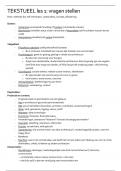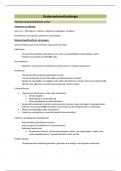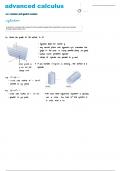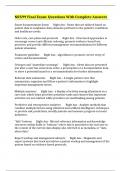From: Introduction to Quantum Mechanic s, by D.J. Griffiths
Door: Marenthe Hopma
07-11-2013, 2𝑛𝑑 edition “Introduction to Quantum Mechanics”
,Inhoud
1. The Wave Function ............................................................................................................................. 3
2. Time-Independent Schrödinger Equation .......................................................................................... 5
2.1 Stationary States .......................................................................................................................... 5
2.2 The Infinite Square Well ............................................................................................................... 6
2.3 The Harmonic Oscillator ............................................................................................................... 7
2.3.1 Algebraic Method .................................................................................................................. 7
2.3.2 Analytic Method .................................................................................................................... 8
2.4 The Free Particle ........................................................................................................................... 9
2.5 The Delta-Function Potential ...................................................................................................... 10
2.5.1 Bound States and Scattering States ..................................................................................... 10
2.5.2 The Delta-Function Well ...................................................................................................... 10
2.6 The Finite Square Well................................................................................................................ 11
3. Formalism......................................................................................................................................... 13
3.1 Hilbert Space .............................................................................................................................. 13
3.2 Observables ................................................................................................................................ 13
3.2.1 Hermitian Operators............................................................................................................ 13
3.2.2 Determinate States .............................................................................................................. 14
3.3 Eigenfunctions of a Hermitian Operator ..................................................................................... 14
3.3.1 Discrete Spectra .................................................................................................................. 14
3.3.2 Continuous Spectra ............................................................................................................. 14
3.4 Generalized Statistical Interpretation......................................................................................... 15
3.5 The Uncertainty Principle ........................................................................................................... 15
3.5.1 Proof of the Generalized Uncertainty Principle ................................................................... 15
3.5.2 The Minimum-Uncertainty Wave Packet ............................................................................. 16
3.5.3 The Energy-Time Uncertainty Principle ............................................................................... 16
3.6 Dirac Notation ............................................................................................................................ 16
4. Quantum Mechanics in Three Dimensions ....................................................................................... 18
4.1 Schrödinger Equation in Spherical Coordinates.......................................................................... 18
4.1.1 Seperation of Variables ....................................................................................................... 18
4.1.2 The Angular Equation .......................................................................................................... 18
4.1.3 The Radial Equation ............................................................................................................. 20
4.2 The Hydrogen Atom ................................................................................................................... 21
4.2.1 The Radial Wave Function ................................................................................................... 21
1
, 4.2.2 The Spectrum of Hydrogen .................................................................................................. 23
4.3 Angular Momentum ................................................................................................................... 24
4.3.1 Eigenvalues .......................................................................................................................... 24
4.3.2 Eigenfunctions ..................................................................................................................... 25
4.4 Spin............................................................................................................................................. 26
4.4.1 Spin ½ .................................................................................................................................. 26
4.4.2 Electron in a Magnetic Field ................................................................................................ 27
4.4.3 Addition of Angular Momenta ............................................................................................. 27
5. Identical Particles ............................................................................................................................. 29
5.1 Two-Particle Systems ................................................................................................................. 29
5.1.1 Bosons and Fermions........................................................................................................... 29
5.1.2Exchange Forces ................................................................................................................... 29
5.2 Atoms ......................................................................................................................................... 30
5.2.1 Helium ................................................................................................................................. 30
5.2.2 The Periodic Table ............................................................................................................... 31
5.3 Solids .......................................................................................................................................... 32
5.3.1 The Free Electron Gas .......................................................................................................... 32
5.3.2 Band Structure ..................................................................................................................... 33
5.4 Quantum Statistical Mechanics .................................................................................................. 34
5.4.1 An Example .......................................................................................................................... 34
5.4.2 The General Case ................................................................................................................. 35
5.4.3 The Most Probable Configuration ....................................................................................... 35
5.4.4 Physical Significance of 𝜶 and 𝜷 .......................................................................................... 36
5.4.5 The Blackbody Spectrum ..................................................................................................... 38
2
, 1. The Wave Function
To describe the position of a particle at any given time, we use a wave function, called the
Schrödinger Equation:
𝜕𝜓 ℏ2 𝜕 2 𝜓
𝑖ℏ =− + 𝑉𝜓
𝜕𝑡 2𝑚 𝜕𝑥 2
ℎ
Where ℏ = = 1.054572 ∙ 10−34 𝐽𝑠
2𝜋
We define the probability of finding a particle between a and b, at time t as:
𝑏
𝑃 = ∫ |𝜓(𝑥, 𝑡)|2 𝑑𝑥
𝑎
Out if this equation, it follows that the integral |𝜓|2 must be 1 (the particle has to be somewhere).
∞
∫ |𝜓(𝑥, 𝑡)|2 𝑑𝑥 = 1
−∞
So now if 𝜓(𝑥, 𝑡) is a solution to our Schrödinger Equation, then so is 𝐴𝜓(𝑥, 𝑡), where 𝐴 ∈ 𝕔. We can
find a by solving the square integral of 𝐴𝜓(𝑥, 𝑡). This is called normalizing the wave function.
For a particle in state 𝜓, the expectation value of x is given by the equation:
+∞
〈𝑥 〉 = ∫ 𝑥|𝜓(𝑥, 𝑡)|2 𝑑𝑥
−∞
Now as time goes on, 〈𝑥 〉 will change (because of the time dependence of 𝜓), and we might be
interested in knowing how fast it moves. We find that:
𝑑 〈𝑥 〉 𝜕 𝑖ℏ 𝜕 𝜕𝜓 𝜕𝜓 ∗
= ∫ 𝑥 |𝜓|2 𝑑𝑥 = ∫ 𝑥 (𝜓 ∗ − 𝜓) 𝑑𝑥
𝑑𝑡 𝜕𝑡 2𝑚 𝜕𝑥 𝜕𝑥 𝜕𝑥
𝜕𝑥
We can simplify this expression by using integration-by-parts. = 1 and because 𝜓 goes to zero at
𝜕𝑥
(±∞), we can throw away the ground term. Using now another integration-by-parts:
𝑑 〈𝑥 〉 𝑖ℏ 𝜕𝜓
=− ∫𝜓 ∗ 𝑑𝑥 = 〈𝑣 〉
𝑑𝑡 2𝑚 𝜕𝑥
This equation tells u show to calculate 〈𝑣 〉 directly from 𝜓. However, it is more customary to work
with momentum (p = mv), rather than velocity:
𝑑 〈𝑥 〉 𝜕𝜓
〈𝑝 〉 = 𝑚 = −𝑖ℏ ∫ (𝜓 ∗ ) 𝑑𝑥
𝑑𝑡 𝜕𝑥
The expressions obtained for 〈𝑥 〉 and 〈𝑝〉 now are:
〈𝑥 〉 = ∫ 𝜓 ∗ (𝑥)𝜓𝑑𝑥
ℏ 𝜕
〈𝑝 〉 = ∫ 𝜓 ∗ ( ) 𝜓𝑑𝑥
𝑖 𝜕𝑥
3












